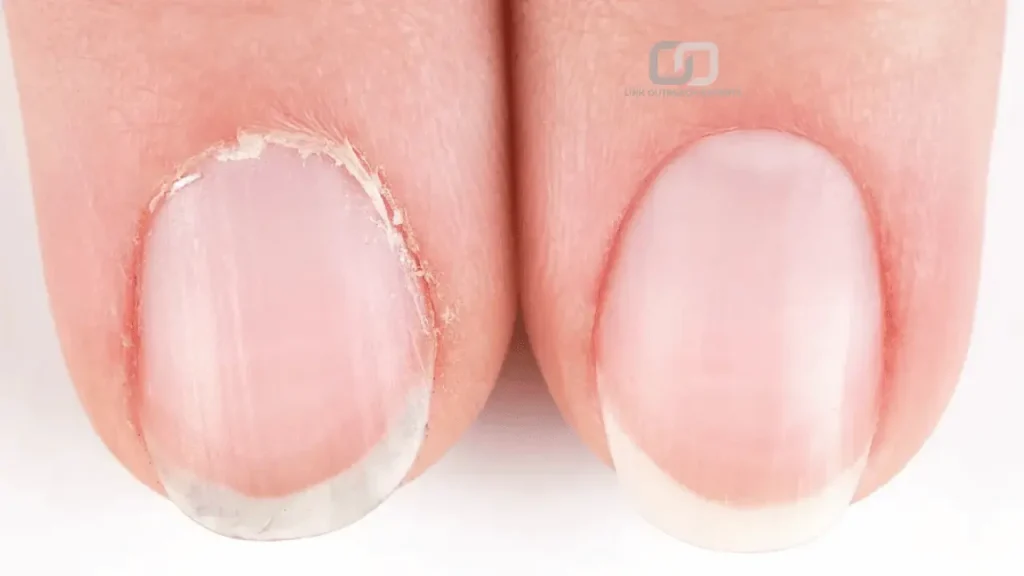Cuticles protect your nails from bacteria and infections. They act as a barrier, keeping the nail bed safe. If cuticles are dry or damaged, they can crack and lead to painful infections. Keeping them healthy ensures strong and smooth nails. Regular care prevents peeling, rough edges, and weak nails. Using moisturizers and avoiding harsh chemicals helps maintain their health.
Many people think cutting cuticles makes nails grow faster. This is not true. Cutting them too much can cause damage and infections. Another myth is that cuticles do not need care. In reality, they need moisture just like skin. Some believe that pushing back cuticles is harmful. If done gently, it helps keep nails clean and neat.
Table of Contents
Common Causes of Cuticle Damage
- Over-Trimming and Picking: Cutting or picking at cuticles too often can weaken the skin around your nails, causing pain and increasing the risk of infection. This makes it harder for your cuticles to heal properly.
- Exposure to Harsh Chemicals: Frequent contact with harsh chemicals like dish soap, cleaning products, and nail polish remover can dry out cuticles. This makes them more likely to crack, peel, and become irritated.
- Lack of Moisture: If you don’t moisturize your cuticles regularly, they become dry and brittle. This can cause them to crack, peel, or even bleed, which leaves them more vulnerable to infections.
- Nail Biting: Nail-biting can damage the skin around your cuticles, leading to inflammation and infection. It also weakens the cuticle area, making it harder for them to stay healthy.
- Cold Weather and Frequent Handwashing: Cold weather and constant handwashing can strip away the natural oils that protect your cuticles, leaving them dry and prone to cracking. It’s important to keep them moisturized during these times.
Daily Care Routine for Healthy Cuticles
- Washing Hands Gently: When washing your hands, avoid harsh soaps that can dry out your cuticles. Use a mild, moisturizing hand wash to keep the skin around your nails soft and hydrated.
- Applying Moisturizer and Cuticle Oil: To keep your cuticles healthy, apply a good moisturizer or cuticle oil every day. This helps lock in moisture and prevents dryness or cracking. Use it after washing your hands and before bed for best results. A healthy nervous system ensures good circulation, which is vital for nail and cuticle health.
- Hydrating Throughout the Day: Drinking plenty of water is important for keeping your cuticles and nails hydrated. Make it a habit to drink water regularly to support overall skin health.
- Using Gloves for Protection: Wear gloves when cleaning, gardening, or doing dishes to protect your cuticles from harsh chemicals and water damage. This will help prevent your cuticles from becoming dry and cracked.
- Avoiding Nail Biting and Picking: Try to break the habit of nail biting or picking at your cuticles. These actions can cause unnecessary damage and lead to infections. Keep your hands busy with stress-relief activities or fidget tools to avoid temptation.
Best Moisturizers and Oils for Cuticle Care
Natural Oils
Natural oils like coconut oil, jojoba oil, and almond oil are excellent for moisturizing cuticles. They are rich in vitamins and essential fatty acids, which help keep the skin hydrated and nourished. Simply massage a small amount into your cuticles for soft, healthy skin.
Cuticle Creams
Specialized cuticle creams contain ingredients like shea butter, vitamin E, and aloe vera. These creams are designed to deeply hydrate and repair dry or cracked cuticles. They work well for daily use and can be applied throughout the day for extra moisture.
Vitamin E Oil
Vitamin E oil is well-known for its healing and skin-nourishing properties. It helps to improve the elasticity of cuticles and prevents dryness. Applying it at night allows it to work while you sleep for maximum benefits.
Argan Oil
Argan oil is rich in antioxidants and essential fatty acids that help repair and protect the skin. It’s great for softening tough cuticles and promoting healthy nail growth. Use it regularly to keep your cuticles hydrated and smooth.
DIY Cuticle Oils
You can make your own cuticle oil by mixing essential oils like lavender or tea tree oil with a carrier oil like olive or coconut oil. This combination provides nourishment and helps fight bacteria, keeping your cuticles healthy and infection-free.
How to Properly Trim and Push Back Cuticles
When and How to Trim Cuticles Safely
Trimming cuticles should be done with care and only when necessary. It’s best to trim them when they’re soft, right after a shower or bath. Use a clean, sharp cuticle nipper to carefully cut excess skin, but avoid cutting too deeply to prevent injury or infection.
Using a Cuticle Pusher Correctly
A cuticle pusher is used to gently push back the cuticles. Soak your hands in warm water to soften the cuticles before pushing them back. Use a gentle motion with a wooden or metal cuticle pusher to avoid damaging the skin. Never force the cuticle back if it feels resistant.
Avoid Over-Pushing or Trimming
While it’s important to keep cuticles neat, avoid over-pushing or trimming too much. Overzealous trimming can lead to painful, irritated cuticles. Keep the process gentle to maintain the natural health of your cuticles.
Protecting Cuticles from Harsh Conditions
Preventing Damage from Cold Weather
Cold weather can dry out your cuticles, leading to cracking and peeling. To protect them, wear gloves when going outside in chilly conditions. You can also apply a thick moisturizer or cuticle cream before heading out to lock in moisture.
How to Protect Cuticles from Chemicals
Harsh chemicals found in cleaning products, detergents, and nail polish removers can damage your cuticles. Always wear gloves when handling these products to create a barrier. Consider using natural or gentle alternatives when possible to reduce the risk of irritation.
Safe Practices for Frequent Handwashing
Frequent handwashing, especially in dry environments, can strip moisture from your cuticles. After washing your hands, apply a hydrating hand cream or cuticle oil to replenish moisture. This will help keep your cuticles soft and protected throughout the day.
Use Moisturizers for Extra Protection
Regularly moisturizing your cuticles is key to protecting them from harsh conditions. Look for moisturizers with ingredients like shea butter, aloe vera, or vitamin E. Applying them daily ensures your cuticles stay hydrated and resilient against environmental stressors.
Diet and Hydration for Stronger Cuticles
To strengthen your cuticles, it’s important to focus on a balanced diet rich in essential vitamins. Vitamin A helps repair skin around the cuticles, while vitamin C promotes collagen production for healthy skin. Vitamin E is great for moisturizing and protecting the cuticles from damage. You can find these vitamins in foods like carrots, citrus fruits, and nuts. Eating a variety of nutrient-dense foods supports overall cuticle health.
Hydration plays a significant role in cuticle health as well. When you’re well-hydrated, your skin stays soft, reducing the chance of cracks and dryness around your nails. Drinking plenty of water, around 8 glasses a day, helps keep your cuticles hydrated and healthy. It’s a simple step that can make a noticeable difference in the look and feel of your cuticles.
Incorporating biotin-rich foods into your diet can also support stronger nails and cuticles. Foods like eggs, almonds, and avocados provide biotin, which helps improve nail strength and overall skin health. Omega-3 fatty acids found in fish like salmon, as well as seeds, help keep your skin moisturized, further protecting your cuticles from drying out.
Conclusion
Taking proper care of your cuticles is essential for maintaining healthy nails and preventing infections. Regular moisturizing, gentle trimming, and protection from harsh conditions help keep your cuticles soft and strong.
By following a simple daily routine, like applying cuticle oil and wearing gloves when needed, you can prevent damage. Eating a balanced diet and staying hydrated will also support cuticle health. Consistency is key to keeping your cuticles in top condition, ensuring they stay healthy and looking great.


